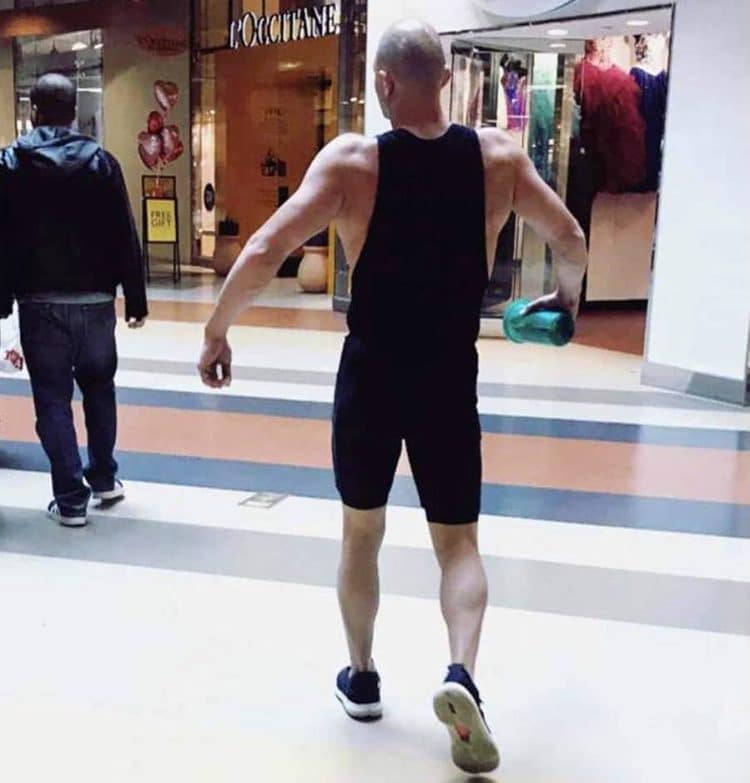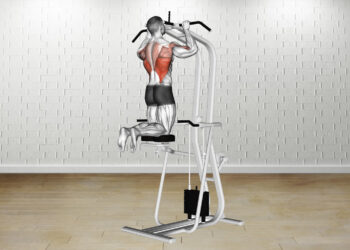Every bodybuilder knows that getting HUGE takes a lot of time, effort, and energy. As well as training your butt off in the gym, you also need to get plenty of sleep and eat like your life depends on it.
After years of dedication, you’ll be rewarded with a body that turns heads and makes people envious.
But, on the downside, big muscles can also be something of an impediment. Skinny jeans are impossible to pull up past your thighs, and good luck finding a suit jacket that fits your chest and shoulders but doesn’t come down to your knees. Even T-shirts and shorts can end up being so tight that they cut off the blood to your extremities.
And while these ARE real-world bodybuilding problems, there are some people who act like they’ve got big muscles, even though it’s clear to everyone around them that they are actually far from muscular.
You’ll often see guys walking with their legs apart like they’ve got Tom Platz-sized thighs. They waddle around like they’ve got super-sized legs when, in reality, their tree trunks are more like toothpicks.
Others hold their arms away from their sides like they’re resting on massive lats when there is nothing but thin air between their arms and their torsos. This condition is known as Invisible Lat Syndrome, or ILS for short.
Level Up Your Fitness: Join our 💪 strong community in Fitness Volt Newsletter. Get daily inspiration, expert-backed workouts, nutrition tips, the latest in strength sports, and the support you need to reach your goals. Subscribe for free!
In this article, we reveal the causes of ILS and how to treat and cure this common condition.
What is Invisible Lat Syndrome (ILS)?
Invisible lat syndrome (ILS) is a humorous term used to describe individuals who appear to hold their arms away from their bodies, as if their lats (latissimus dorsi muscles) are more prominent than they actually are. Imagine having a pair of volleyballs under your arms; that’s how it might feel. It’s like a post-gym ‘pump’, but exaggerated. While many of us experience a temporary muscle swelling after intense exercise, we soon relax and let our arms return to their natural position. ILS sufferers, however, maintain this stance consistently, as though channeling their inner Schwarzenegger without the same muscle size.
Other Gym-related Diseases
ILS tends to be most common in younger males and is often accompanied by one or several other gym-related diseases, such as:
- It’s all you bro syndrome – lifters who ask for a spot but then load more weight on the bar than they can handle, so their spotter ends up doing all the work.
- Grunt-itis – the condition where wannabe strongmen shout and holler to draw attention to themselves before or during a “big lift,” that probably isn’t actually all that impressive.
- Every day is chest and biceps day syndrome – lifters who do nothing but bench press and curls.
- Creepoid-itis – guys who think it’s acceptable to make a pass at someone at the gym, make suggestive comments, or otherwise act like a sexual predator.
- Snap city syndrome – exercisers who use any means possible to lift a weight clearly too heavy for them, putting dangerous amounts of stress on their muscles and skeletal system. Here is a classic example of an SNS sufferer in action:
Now, gyms SHOULD be safe spaces where everyone feels accepted, and there is even a place for the grunters, snappers, and bros. But Invisible Lat Syndrome is a plague spreading like a new pandemic, and it’s time to STAMP IT OUT!
So, whether you want to make sure you don’t catch ILS or want to know how to cure it, we are here to help.
What Causes Invisible Lat Syndrome?
The physical cause of ILS is actually pretty straightforward – sufferers simply do not pay enough attention to training their lats. Because of this, their lats are small and underdeveloped and often overshadowed by other body parts, such as the arms, shoulders, and pecs.
In many cases, neglecting the lats is part of another syndrome – mirror muscle fixation – where lifters only train the muscles on the front of their bodies.
The solution to ILS is, thankfully, pretty simple, and a regular prescription of lat pulldowns, pull-ups, rows, and deadlifts is the cure.
Of course, if you’ve been neglecting your lats for a while, you will probably need to adopt a more aggressive approach to back training to bring your lats in line with the rest of your body.
The good news is that we’re sympathetic to your problem and are here to help!
Invisible Lat Syndrome Solution Workout
Do you look like you are carrying rolls of carpet under your arms? Do you turn sideways to go through doorways despite being a normal-sized guy? Could the local kids use that space under your arms for shooting baskets?
Yes?
Then you probably have Invisible Lat Syndrome.
The first thing to do if you are a victim of ILS is to let your arms hang naturally by your sides. You aren’t fooling anyone, and you’ll probably find that most people are laughing about you behind your slender back.
So, drop your arms down and stop acting like a delusional idiot!
Secondly, it’s time to start taking your diet more seriously and eating for gains. That means protein at every meal, plenty of veggies and fruits, some whole grains, and less junk food. If you want to be big, you’ve got to eat big. Food is fuel for muscle growth. Read more about eating for muscle gains here.
Finally, you MUST knuckle down and start training your back like you mean it. We’re talking two big back workouts per week. This may mean giving up one of your chest workouts or spending less time on your arms, but that’s the price you’ve got to pay to cure your ILS.
To save you from coming up with your own cockamamie back workout, we’ve written one for you. Rest assured, this workout is 100% approved by the Anti-ILS Association of America and is guaranteed to give you wings!
Level Up Your Fitness: Join our 💪 strong community in Fitness Volt Newsletter. Get daily inspiration, expert-backed workouts, nutrition tips, the latest in strength sports, and the support you need to reach your goals. Subscribe for free!
Warm up Before you Work out
Before you start any workout, make sure you spend a few minutes preparing your muscles and joints for what you are about to do. Start with 5-10 minutes of easy cardio; rowing is a good choice. Follow that with a few dynamic mobility and flexibility exercises for your shoulders, elbows, and lower back. For more on how to warm up for strength training, check out this article.
Do these workouts as part of a split routine, e.g.:
- Monday – Back (#1)
- Tuesday – Chest
- Wednesday – Legs
- Thursday – Rest
- Friday – Back (#2)
- Saturday – Shoulders, and Arms
- Sunday – Rest
Back Workout #1
| # | Exercise | Sets | Reps | Recovery |
| 1 | Deadlift | 4 | 4-6 | 2-3 minutes |
| 2 | Pull-up * | 3 | 6-8 | 2 minutes |
| 3 | Single-arm dumbbell row | 3 per arm | 8-10 | 90 seconds |
| 4 | Barbell shrug | 2 | 10-12 | 60 seconds |
| 5 | Barbell bent-arm pullover | 2 | 10-12 | 60 seconds |
* Do bodyweight, weighted, or band-assisted pull-ups, so you stay in the 6-8 reps per set range.
Back Workout #2
| # | Exercise | Sets | Reps | Recovery |
| 1 | Pendlay row | 4 | 4-6 | 2-3 minutes |
| 2 | Close grip lat pulldown | 3 | 6-8 | 2 minutes |
| 3 | Seated cable row | 3 | 8-10 | 90 seconds |
| 4 | Face pull | 2 | 10-12 | 60 seconds |
| 5 | Straight arm pulldown | 2 | 10-12 | 60 seconds |
Invisible Lat Syndrome – FAQs
Do you have a question about Invisible Lat Syndrome or back training in general? No sweat – we’ve got the answers!
1. Is ILS an actual disease?
Okay, you got us; ILS is not a REAL disease. It’s not contagious, and it’s not caused by a germ or virus. However, it affects a lot of people and is becoming more common every year. Thankfully, the “cure” is pretty straightforward – hard, heavy, and frequent back training.
2. My buddy has ILS – how do I tell him?
If you know someone with Invisible Lat Syndrome, you have a couple of options. Firstly, you can ignore it and hope they notice it themselves. Then, ask them to join you for a back workout to see if that triggers anything. If they have ILS, back training may be something they’re unfamiliar with.
If that doesn’t work, you could drop some subtle hints like, “hey dude, what’s wrong with your arms? Why do they stick out like that?”
If none of these approaches works, it’s time to show some tough love and tell them what they’re doing. This truth bomb could be just what they need to realize they have a problem and the incentive they need to fix it.
Finally, remember that your buddy needs to want to change. If they don’t, all your guidance and input will be wasted.
3. Aren’t deadlifts more of a leg exercise than a back exercise?
Deadlifts involve knee and hip extension, giving your quads, hamstrings, and glutes a great workout. However, keeping the barbell close to your legs involves your lats, while keeping your spine stable hits your erector spinae, traps, and rhomboids.
Because of the big weights involved, deadlifts put a lot of tension through your entire back, even though those muscles work isometrically or statically. All this muscle tension means that deadlifts are an awesome back-building exercise and one of the best cures for Invisible Lat Syndrome.
4. How long will it take to cure ILS?
Unfortunately, this question is impossible to answer. It depends on how advanced your ILS is, how long you’ve neglected your lats, and how committed you are to fixing the problem.
So, while we can’t tell you when you’ll cure your ILS, we can confidently say that every back workout you successfully complete will take you one step closer to developing a back you can be proud of.
5. Are there any supplements that will speed up lat growth?
The best supplement for curing ILS is iron – as in the weights you’ve got to lift!
That said, there are a few products that may make your workouts more effective, help you recover better between workouts, or otherwise enhance your gym performance. These include:
- Protein powder to make getting enough dietary protein easier
- Creatine to boost muscle growth and workout performance
- Pre-workout for more training energy, focus, and a better pump
- BCAAs and EAAs to speed up recovery
- ZMA for better sleep and increased testosterone production
6. What else can I do to maximize lat growth?
Your gym workouts are only part of what you need to do to cure Invisible Lat Syndrome. You also need to adopt a healthy diet and get plenty of sleep.
Regarding nutrition, you should create a slight calorie surplus to fuel your workouts and muscle growth. While you can build muscle without a surplus, it’s usually a harder, slower process.
You should try and eat about one gram of protein per pound of body weight, consume reasonable quantities of unrefined starchy carbs, and modest amounts of healthy fats. While you don’t have to give up junk food entirely, it should only make up about 10% of your weekly food intake.
Your ILS training will take a lot out of your body, so you need to make sure you get enough sleep each night to optimize recovery and muscle growth. Too little sleep will severely undermine your progress. Shoot for 7-8 hours of sleep per night – and that means weeknights as well as weekends.
Read more about the importance of sleep here.
7. Is it still okay to flex my lats in private?!
No one expects you to overcome ILS overnight. If you are addicted to flexing your lats and find it hard to quit, feel free to do a few lat spreads at home. Doing occasional lat spreads could actually be beneficial as it will strengthen the all-important mind-muscle connection.
But you must resist the temptation to flex your lats while out in public. However, the occasional lat flex at the gym is acceptable.
Closing Thoughts
Invisible Lat Syndrome is not the most serious gym-related disease. That honor goes to “it’s never leg day-itis!” However, ILS is common enough that we need a cure!
The best way to overcome ILS is to train your back like you mean it. Hit your lats hard, heavy, and often, and they’ll grow. Then, you need to keep your arms by your sides and stop peacocking.
Combine these strategies with a healthy diet and plenty of recovery and sleep, and together, we CAN stamp out Invisible Lat Syndrome once and for all!











